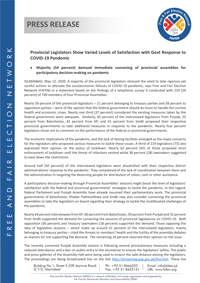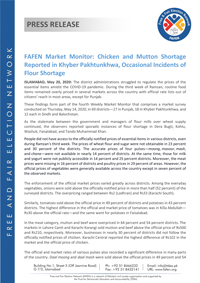ISLAMABAD, May 13, 2020: The enforcement of the officially notified prices of essential commodities continued to deteriorate across the country, mainly due to weak market monitoring mechanisms and unavailability of official prices, says the Free and Fair Election Network’s (FAFEN) Weekly Market Monitor.
The Weekly Market Monitor comprises the market survey conducted in 56 districts – 25 in Punjab, 12 each in Khyber Pakhtunkhwa and Sindh, and seven in Balochistan on Thursday, May 7, 2020.
The observers from several districts reported that the official prices of the essential grocery items were not notified, or easily available. The official prices of wheat flour and sugar were not accessible in 36 percent and 38 percent of the districts. The official prices of four pulses (Moong, Masoor, Mash, and Chana) were missing in nearly 16 percent of the districts, while those for milk and yogurt were not publicly available in 14 percent and 25 percent districts, respectively. Moreover, the meat prices were missing in 11 percent districts and poultry prices in 30 percent districts. However, the vegetable’s official prices were generally available across the country except in seven percent of the observed markets.
The enforcement of the official market prices varied greatly across the districts. Among the routine vegetables, the onions were sold above the officially notified price in more than half (51 percent) of the observed districts. The overpricing of onions ranged between Rs. 2 (Sheikhupura) and Rs. 35 (Panjgur). Similarly, tomatoes were sold above official prices in 44 percent districts and potatoes in 36 percent districts. The highest difference in the official and market prices of these two vegetables was noted in Gujrat where potatoes were sold at Rs. 30 above the official price, and tomatoes at Rs. 35 above the official price.
In the meat category, mutton and beef were overpriced in 57 percent and 51 percent districts, respectively. The markets in Karachi sold mutton and beef above the official price at Rs. 460 and Rs. 400, respectively. Moreover, markets in nearly 27 percent districts did not follow the officially notified prices of chicken. Karachi Central reported highest difference of Rs. 112 in the market price and official price of chicken.
The official and market prices of various pulses also recorded a major difference in many parts of the country. Daal Chana and Daal Mash were sold above the official prices in 51 percent and 50 percent of the districts. Daal Mash was sold at Rs. 140 above the officially notified rate in a Pakpattan market while Daal Chana was sold at Rs. 85 above the official price in a Loralai market. The market prices of Daal Masoor and Daal Mong varied from the official prices in around 43 percent and 20 percent of the districts, respectively.
The refined sugar and wheat flour were sold above official rates in 36 percent and 29 percent districts, respectively. A 20 kilogram wheat flour bag was sold at Rs. 130 above the official price in Malir. The refined sugar was being sold at Rs. 27 above the market price in Lakki Marwat. The market prices of per dozen eggs were above the officially notified prices in 23 percent districts while the milk and yogurt prices were also higher than the official rates in nearly a third of the observed districts.
Realizing the need for an independent and regular assessment of the availability of essential commodities across the country, TDEA-FAFEN is generating the weekly market monitors covering 15 essential kitchen items including basic groceries such as wheat, pulses, oil, sugar and perishable commodities like meat, and vegetables. The official prices were taken from the district administration, or market committees while the wholesale prices were gathered through the market surveys. In the case of Punjab, the government price app “Qeemat Punjab” was also used to fetch the officially notified price.




